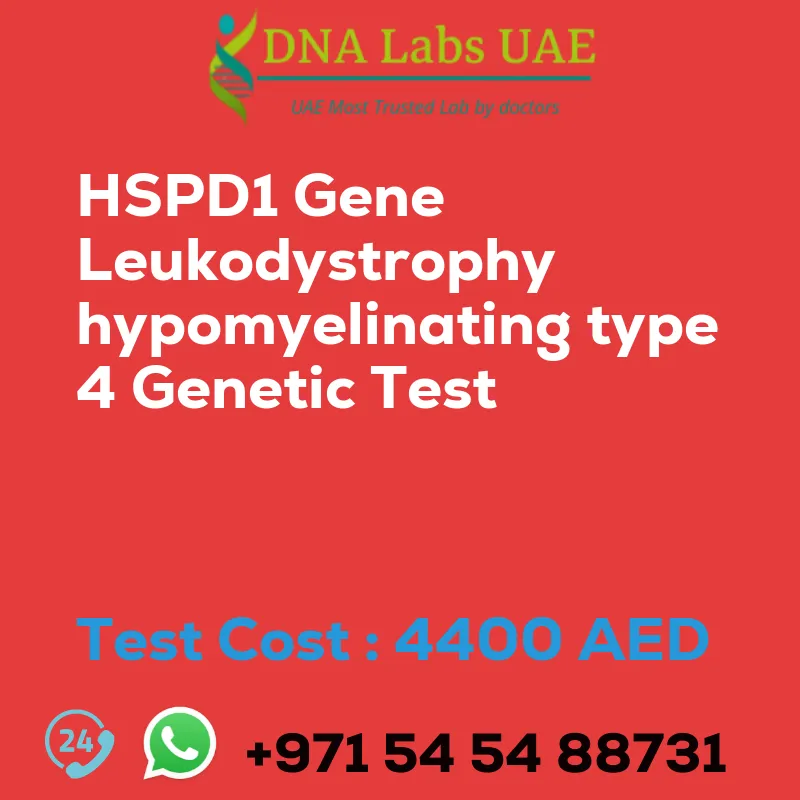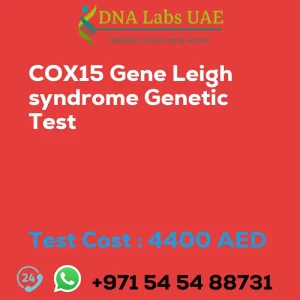HSPD1 Gene Leukodystrophy hypomyelinating type 4 Genetic Test
Welcome to DNA Labs UAE, where we offer the HSPD1 Gene Leukodystrophy hypomyelinating type 4 Genetic Test. This test is designed to analyze the HSPD1 gene and identify any mutations or variations that may be present in individuals with leukodystrophy hypomyelinating type 4.
Test Components
- Price: 4400.0 AED
- Sample Condition: Blood or Extracted DNA or One drop Blood on FTA Card
- Report Delivery: 3 to 4 Weeks
- Method: NGS Technology
- Test Type: Neurological Disorders
- Doctor: Neurologist
- Test Department: Genetics
Pre Test Information
Before undergoing the HSPD1 Gene Leukodystrophy hypomyelinating type 4 Genetic Test, it is important to provide a clinical history of the patient. Additionally, a genetic counseling session may be conducted to draw a pedigree chart of family members affected with HSPD1 Gene Leukodystrophy hypomyelinating type 4.
Test Details
The HSPD1 gene is associated with a rare genetic disorder called leukodystrophy hypomyelinating type 4. This disorder affects the development and maintenance of myelin, the protective covering of nerve fibers in the brain and spinal cord. Mutations in the HSPD1 gene can disrupt the function of a protein called heat shock protein 60 (HSP60), which is involved in the proper folding of other proteins.
A next-generation sequencing (NGS) genetic test can be used to analyze the HSPD1 gene and identify any mutations or variations that may be present. This type of test can provide valuable information about the genetic cause of leukodystrophy hypomyelinating type 4 and help in making a diagnosis.
NGS genetic testing involves sequencing the DNA of an individual to identify specific variations or mutations in genes of interest. This can be done using a small blood sample or other tissue samples. The DNA sequence data is then compared to a reference sequence to identify any differences.
Genetic testing for leukodystrophy hypomyelinating type 4 can be helpful for confirming a diagnosis, predicting the likelihood of passing the condition on to offspring, and providing information for genetic counseling. It may also be used for research purposes to better understand the disease and develop potential treatments.
| Test Name | HSPD1 Gene Leukodystrophy hypomyelinating type 4 Genetic Test |
|---|---|
| Components | |
| Price | 4400.0 AED |
| Sample Condition | Blood or Extracted DNA or One drop Blood on FTA Card o |
| Report Delivery | 3 to 4 Weeks |
| Method | NGS Technology |
| Test type | Neurological Disorders |
| Doctor | Neurologist |
| Test Department: | Genetics |
| Pre Test Information | Clinical History of Patient who is going for HSPD1 Gene Leukodystrophy hypomyelinating type 4 NGS Genetic DNA Test A Genetic Counselling session to draw a pedigree chart of family members affected with HSPD1 Gene Leukodystrophy hypomyelinating type 4 |
| Test Details |
The HSPD1 gene is associated with a rare genetic disorder called leukodystrophy hypomyelinating type 4. This disorder affects the development and maintenance of myelin, the protective covering of nerve fibers in the brain and spinal cord. Mutations in the HSPD1 gene can disrupt the function of a protein called heat shock protein 60 (HSP60), which is involved in the proper folding of other proteins. A next-generation sequencing (NGS) genetic test can be used to analyze the HSPD1 gene and identify any mutations or variations that may be present. This type of test can provide valuable information about the genetic cause of leukodystrophy hypomyelinating type 4 and help in making a diagnosis. NGS genetic testing involves sequencing the DNA of an individual to identify specific variations or mutations in genes of interest. This can be done using a small blood sample or other tissue samples. The DNA sequence data is then compared to a reference sequence to identify any differences. Genetic testing for leukodystrophy hypomyelinating type 4 can be helpful for confirming a diagnosis, predicting the likelihood of passing the condition on to offspring, and providing information for genetic counseling. It may also be used for research purposes to better understand the disease and develop potential treatments. |







